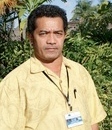 At the three-day ‘high level’ Deep Sea Minerals Mining Meeting workshop key issues were identified that need to be addressed towards the commercialisation of deep seabed mining in the Pacific region.
At the three-day ‘high level’ Deep Sea Minerals Mining Meeting workshop key issues were identified that need to be addressed towards the commercialisation of deep seabed mining in the Pacific region.
The EU funded, SPC/SOPAC Division-organised Meeting workshoptook place from June 6 to 8 in Fiji, and focused on legislative, regulatory, capacity requirements, and the environment, all of which pertain to deep-sea minerals and mining.
Representing Samoa at the workshop was Mr. Lameko Talia, Principal Scientific Officer, Geology and Geophysics of the Meteorology Division of the Ministry of Natural Resources and Environment, who said that the issues raised had shown the imperative for Samoa to put regulatory policy in place, and for a review of existing seabed mineral data.
Mr. Talia said he was inspired by the workshop, and was eager to see a ‘Sea Act’ formulated that would directly apply to Deep Sea Minerals and Mining.
“We need to put policies in place, and we definitely would want to work with SPC/SOPAC Division on this.”
Samoa has a principal, overarching The Lands, Surveys and Environment Act, passed in 1989, The Land for Foreign Purposes Act 1992/1993 and National regulations, policies and strategies that cover sand and gravel mining, water, and the conservation of flora and fauna, parks and reserve lands.
Apart from the 1989 Act, there is “no provision specifically for the mining of minerals, whether on land or offshore.”
Mr. Talia said that at present, mining on Samoa was confined to coastal sand mining and aggregate quarrying for building roads and other infrastructure, and that deep sea mineral mining for commercial purposes “would be a first for Samoa.”
“Past deep-sea mineral research led to the discovery of deposits of cobalt–rich crust, within Samoa’s Extended Economic Zone (EEZ). The deposits are medium sized in comparison with those discovered in the EEZ of offshore Cook Islands for example, but there are deposits there,” said Mr.Talia.
“All previous research says the amounts are worthwhile investigating further, and could possibly generate economic incentives for the people of Samoa.”
“We have a potential resource, but the existing data needs to be reviewed. If we are economically minded, we need to pinpoint exactly how much ore exists with a thorough exploration using the new 3D bathymetry technology that is now available. This is essential if there is to be any possibility of mining these deposits.”
Mr. Talia said it was important to look to the examples set by other Pacific Island nations, such as Papua New Guinea and Nauru, and make sure that the funds generated are channeled back to the community, to improve the country’s GDP.
“This raises issues of transparency, and as a vital part of any investment in seabed mining, information must be published for public review. In this way there is no possibility of misappropriation, and all parties are kept honest,” explained Mr. Talia.
“It is essential that we enforce contracts, make sure that all safeguards are in place before, during and at the end of a mining operation,” said Mr. Talia.
“For example, we don’t want old machinery left on the beaches. Samoa has a beautiful but fragile environment, and as tourism is a major revenue earner for the country, it is essential to maintain pristine waters and beaches.
“We don’t want people to stay away because environment has been degraded as a result of mining activities.”
Mr. Talia said that in order to develop the possibility of off-shore, deep sea mineral mining, it would be necessary to follow up, through the Ministry of Foreign Affairs, Samoa’s status in relation to making the country’s Maritime Boundaries submissions to the United Nations.
“As a geologist from the Ministry of Natural resources, I found this to be an inspiring workshop. There is no other Ministry in Samoa to regulate mineral resources, so we are the right people to be taking on this topic. Perhaps further along, we could develop a specific Minerals Division,” Mr. Talia concluded.
Caption: Mr Lameko Talia of Samoa during a break at the Deep Sea Minerals Meeting in Nadi, Fiji.





